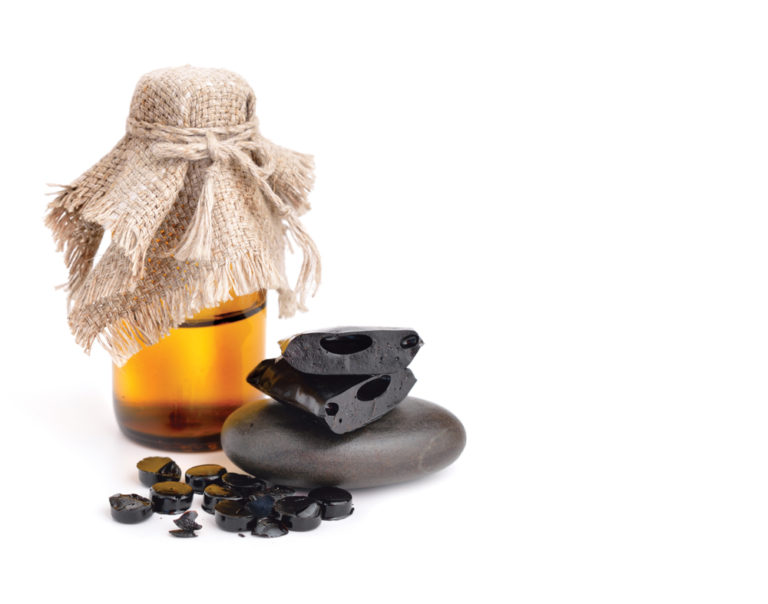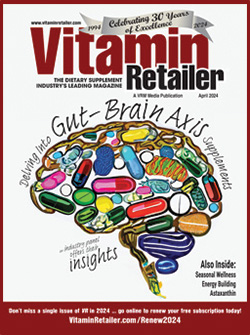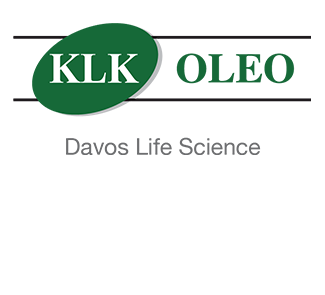The ayurvedic medical tradition never ceases to amaze me. It is rich in so many fascinating natural remedies, which have been time-tested over thousands of years. Furthermore, quite a few ayurvedic remedies have also been the subject of modern scientific research which not only validate traditional use, but sometimes even provide evidence of new applications to human health. Such is the case with shilajit.
What is Shilajit?
Secreted from sedimentary rocks (largely in the Himalayas) shilajit is a pale-brown to blackish-brown exudate, composed of rock humus, rock minerals and organic substances that have been compressed by layers of rock mixed with marine organisms and microbial metabolites.1 Said to carry the healing power of these great mountains,2 shilajit is an important remedy of the ayurvedic Materia Medica and has been used for over 3,000 years as a rejuvenator and adaptogen in a variety of conditions. Interestingly, the Sanskrit meaning of shilajit is “Conqueror of mountain and destroyer of weakness.”3 Among its many applications, shilajit has been used for the management of male reproductive disorders.4,5 Furthermore, shilajit has an extensive history of use in ayurvedic medicine as an aphrodisiac,6-10 and its safety has been well documented based on animal and human studies.11 This article will review several of the evidence-based effects of shilajit, including boosting testosterone, improving sperm parameters, promoting cardiovascular health (which includes nitric oxide boosting), increasing energy production and physical activity, activating collagen production, and providing antioxidant protection against free radicals.
Shilajit for Testosterone
Given its historical use as an aphrodisiac, it is not a big surprise that two modern studies have demonstrated that shilajit has successfully increased testosterone levels in two different male populations. These studies have also demonstrated ancillary benefits associated with shilajit supplementation.
The first study,12 which took place over a period of 90 days, examined the effects of 100 mg shilajit (as PrimaVie purified shilajit, Natreon) twice daily in 28 infertile male patients with oligospermia (a condition with low sperm concentration). This study tested serum levels of testosterone, follicle-stimulating hormone (FSH), and malondialdehyde (MDA). In men, FSH helps control the production of sperm. MDA is a marker for oxidative stress. The results of this study showed that supplementation with shilajit significantly increased serum testosterone by 23.5 percent (P < 0.001), increased FSH by 9.4 percent (P < 0.05), and decreased MDA in semen by 18.7 percent. In addition, there was significant (P < 0.001) improvement in sperm parameters, including 37.6 percent increase in sperm mobility, 61.4 percent increase in total sperm count, 12.4-17.4 percent increase in motility. Liver and kidney tests also verified the safety of supplementation of PrimaVie shilajit.
The second study13 also took place over 90 days, and was randomized, double-blind, and placebo-controlled. In this case, 98 healthy male volunteers (45-55 years) participated, and took 250 mg/twice of PrimaVie shilajit daily, or placebo. Total and free testosterones, luteinizing hormone (LH), FSH, and DHEA (as DHEAs) were measured on days 0 (baseline), 30, 60 and 90. In men, LH stimulates the production of testosterone and DHEA can be converted to testosterones in the body. Results showed that the shilajit treated group experienced an increase of testosterone levels on days 30 (6.82 percent), 60 (3.09 percent) and 90 (20.45 percent, P<0.05) compared to baseline. By contrast, there were decreases in testosterone levels in the placebo group (p<0.05). Testosterone levels in the shilajit group were significantly better those of the placebo group at day 90 (P<0.05). Levels of free testosterone in the shilajit group significantly increased by 19.14 percent (p<0.05), which was significantly higher than the placebo group (P<0.05). In addition, FSH levels significantly increased (p<0.004) in the shilajit group, which was significantly better than the placebo group on day 90. Also, DHEAs increased by 31.35 percent on day 90 in the shilajit group, which was significantly higher than baseline or the placebo group (p<0.05).
Despite the fact that the two studies summarized above were conducted on oligospermic and healthy male populations using 200 mg and 500 mg shilijit daily, the increase in T levels was markedly similar: 23.5 percent and 20.45 percent, respectively. This similarity suggests the potential for a greater likelihood of efficacy in different populations.
Shilajit for Cardiovascular Health
The endothelium (inner lining) of blood vessels uses nitric oxide (NO)—a compound produced naturally in the body—to signal the surrounding smooth muscle to relax, resulting in vasodilation (the widening of blood vessels), which increases blood flow. This process has a profound effect on your cardiovascular health, sexual health, physical performance and so much more. This is significant to the discussion of shilajit, based upon the following study.
To examine its effect in modifying cardiovascular risk, a 12-week, prospective, randomized, double blind, placebo-controlled trial14 was conducted with 40 type-2 diabetic patients (aged 18-75 years) who were treated with 250 mg PrimaVie shilajit, twice daily, or placebo (n=20; 16 men and four women in shilajit group and 14 men and six women in placebo group), and were asked to review for follow-up visits at four weeks, eight and 12 weeks of therapy. The results demonstrated quite a few cardiovascular benefits associated with shilajit. One of these was about a 30 percent increase in NO levels (P<0.001). Other benefits included a significant reduction in endothelial dysfunction (poor functioning of the inner lining of blood vessels) as measured by reflection index (RI) (P<0.001), a significant increase in subendocardial viability ratio, which is an indicator of heart workload and perfusion (O2 supply vs. demand) (P<0.05), and a significant increase in cardiac output. There were also significant increases in NO, glutathione, a powerful antioxidant (P<0.05), and a significant decrease in high sensitivity C-reactive protein, a marker for inflammation (P<0.001). Furthermore, compared to placebo, treatment with shilajit showed a significant:
• Reduction in levels of total cholesterol (P<0.001),
• Reduction in levels of LDL-cholesterol (P<0.01),
• Reduction in levels of triglycerides (P<0.01),
• Reduction in levels of VLDL-cholesterol (P<0.01),
• Reduction in levels of glycosylated hemoglobin A1c (P<0.001),
• Increase in levels of HDL-C levels (P<0.01).
Once again, treatment with PrimaVie shilajit was well tolerated, and there were no serious adverse events recorded in the study.
Shilajit for Energy and Physical Activity
Forty-eight healthy volunteers, including recreational athletes and sports persons, participated in a randomized, placebo controlled, double blind, cross-over, clinical trial15 to examine the effect of a placebo or 250 mg PrimaVie shilajit, twice daily, on improving endurance capacity. The results showed that there was about a nine to 13 percent increase in exercise time in the shilajit groups (P= 0.0028), while there were no significant changes in exercise time in the placebo group. This study also measured metabolic equivalents (METs). METs are a unit used to estimate the amount of oxygen used by the body during physical activity. The harder the body works during the activity, the more oxygen is consumed and the higher the MET level. In the study, there was a significant increase in the METs value after three weeks of shilajit treatment in comparison to placebo treatment at same time points. Researchers concluded that the increase in the METs explains the increase in the exercise time resulting from supplementation with shilajit. No adverse reactions were reported with the PrimaVie shilajit.
In another study,16 six normal human volunteers received 200 mg of PrimaVie shilajit, and then engaged in aerobic exercise. The subjects continued taking shilajit for 15 days, at which point they again engaged in aerobic exercise. The purpose was to determine if shilajit could improve biochemical indicators of energy production. The results showed a significant improvement in energy from supplementation with shilajit. Specifically, levels of ATP (the body’s “energy currency”) increased about 14 percent. Likewise, the level of fitness also increased about 15 percent—which was impressive since the subjects in the study were not sports trained individuals. Another interesting change was that shilajit normalized the coenzyme Q10 levels in whole blood and reduced the uric acid levels, demonstrating efficacy as energy booster.
Shilajit for Up-regulation of Genes Coding for Collagen and Other Extra Cellular Matrix (ECM) Proteins
In the dietary supplement industry, discussions about collagen typically take place within the context of its role in healthy skin, as well as joint health. But as a connective tissue protein, collagen also plays a vital role in the maintenance and repair of other tissues, including muscle tissue. Shilajit’s influence on this particular role was investigated in an open-label, longitudinal study17 including 16 overweight and obese (BMI 30.0 to 34.9) Americans aged 21–70 who consumed 250 mg of PrimaVie shilajit, twice daily, for eight weeks, followed by an additional four-week supplementation period combined with exercise. The reason for studying overweight and obese subjects was that muscle performance is often compromised in this group. Blood samples and skeletal muscle biopsies were taken at baseline, eight weeks of supplementation and additional four weeks of supplementation with added exercise. Real-Time PCR analysis of the biopsy samples showed that shilajit up-regulated genes related to collagen– COL1A1, COL1A2, COL5A2, COL6A3, COL14A1, Fibrillin (FBN1), tenacin (TNXB), decorin (DCN), myoferlin (MYOF), elastin (ELN) and fibronectin (FN1) by seven to 80 times without exercise, but 20-1,300 times when combined with exercise. This means that shilajit was able to up-regulate collagen and other ECM genes significantly and synergistically when combined with exercise. The extracellular matrix (ECM) is the non-cellular component present within all tissues and organs, and provides not only essential physical scaffolding for the cellular constituents but also initiates crucial biochemical and biomechanical cues that are required for tissue formation, differentiation and repair.
Shilajit for Antioxidant Protection
Nowadays it seems that every other nutraceutical and its cousin touts antioxidant properties—which can make it hard to get too excited over a new antioxidant. However, when a nutraceutical has demonstrated activity against five different key types of free radicals, it is worth taking notice. Such is the case with shilajit. An ORAC 5.0 test (the gold standard in antioxidant testing) was conducted on PrimaVie shilajit. The results showed that PrimaVie provided antioxidant protection against peroxyl radical, hydroxyl radical, superoxide anion, singlet oxygen and peroxynitrite. These five types of free radicals contribute toward a broad range of oxidative damage in the body, including nucleic acid/DNA damage, skin damage, collagen damage, and can contribute toward the development of certain cancers, hepatitis, and chronic inflammation and cardiovascular damage.18 Furthermore, PrimaVie had a total ORAC value of 9,855 μmole/gram.19 To put this into perspective, a twice daily dose of PrimaVie shilajit provides the protective ORAC antioxidant equivalent of about one serving of vegetables.20,21
Conclusion
Shilajit is an ayurvedic remedy in use for over 3,000 years as a rejuvenator and adaptogen. Modern research has demonstrated that PrimaVie shilajit is safe and, in doses ranging from 200-500 mg/day, has several of the evidence-based effects, including boosting testosterone, improving sperm parameters, promoting cardiovascular health (which includes NO boosting), increasing energy production and physical activity, activating production of collagen and other extracellular matrix proteins, and providing antioxidant protection against free radicals. VR
References:
1 Ghosal, S. The aroma principles of Gomutra and Karpuragandha Shilajit. Indian J Indg Med 1994;11:11–14.
2 David, F. and Vasant, L. 2001. The Yoga of Herbs. Twin Lakes, WI: Lotus Press.
3 Agarwal SP, Khanna R, Karmarkar R, Anwer MK, Khar RK. Shilajit: a review. Phytother Res. 2007 May;21(5):401-5.
4 Sharma, P.V. 1998. Charaka Samhita. Chowkhambha Orientalia Chikitsasthana, Varanasi, Karaprchitiya RasayanaPada, 4th Edition, Volume 2. Varanasi, U.P., India: Chowkhambha Orientlia Chikitsasthana.
5 Ravindra S, Reeta M, Sanka jyoti D, Swapnali D, Rama MA. Management of Male Infertility: Ayurvedic Approach. In Res J Pharm. 2013;4(6):6-7.
6 Panigrahi D, Suresh P. Shilajatu The Panacea: A Review. Int J Ayu Pharm Chem. 2014;1(1):85-95.
7 Firke AC, Pargunde S. Shuddha Shilajatu with its pharmacological actions. PunarnaV. 2014;2(3):1-9.
8 Pattonder RK, Chandola HM, Vyas SN. Clinical efficacy of Shilajatu (Asphaltum) processed with Agnimantha (Clerodendrum phlomidis Linn.) in Sthaulya (obesity). Ayu. 2011 Oct;32(4):526-31.
9 Agarwal SP, Khanna R, Karmarkar R, Anwer MK, Khar RK. Shilajit: a review. Phytother Res. 2007 May;21(5):401-5.
10 Biswas TK, Pandit S, Mondal S, Biswas SK, Jana U, Ghosh T, Tripathi PC, Debnath PK, Auddy RG, Auddy B. Clinical evaluation of spermatogenic activity of processed Shilajit in oligospermia. Andrologia. 2010 Feb;42(1):48-56.
11 Stohs, S.J. Safety and efficacy of shilajit (mumie, moomiyo). Phytother Res 2014;28:475-9.
12 Biswas TK, Pandit S, Mondal S, Biswas SK, Jana U, Ghosh T, Tripathi PC, Debnath PK, Auddy RG, Auddy B. Clinical evaluation of spermatogenic activity of processed Shilajit in oligospermia. Andrologia. 2010 Feb;42(1):48-56.
13 Pandit S, Biswas S, Jana U, De RK, Mukhopadhyay SC, Biswas TK. Clinical evaluation of purified shilajit on testosterone levels in healthy volunteers. Research Unit, J. B. Roy State Ayurvedic Medical College and Hospital, Department of Health and Family Welfare, Government of West Bengal, Kolkata, India. Submitted for publication. 2014.
14 Rani PU, Sravanti IV, Fatima N, Muralidhar N. Salomi R. Study of Shilajit ( PrimaVie) in modifying cardiovascular risk with special reference to Endothelial dysfunction in patients with Type2 Diabetes Mellitus. Department of Clinical Pharmacology and Therapeutics, Nizam’s Institute of Medical SciencesPunjagutta, Hyderabad, Andhra Pradesh, India. Submitted for publication. 2014.
15 Maharaj V, Tripathi PC, Tripathi S, Banerjee D, Islam A. Clinical Evaluation of Safety & Efficacy of Shilajit (PrimaVie-Shilajit for Improving Human Performance In Exercise Study of Healthy Volunteers – a Placebo controlled Study. Final Report Project No.: NAT/CR/20100901. Ramakrishna Mission Ashrama Hospital(Ayurvedic Unit), Narendrapur, Kolkata-700103. 2012.
16 Ghosal S, Pal D, Bhattacharyya S. Pilot Study on the Improvement of Human Performance with PrimaVie® as Energy Booster: Part-IV. Project No.: NAT/CHEM-7/09/06. Natreon Inc. (India), Kolkata CL-18A, Salt Lake City. Sector-II, Kolkata 700 091. 2006.
17 Das A, Datta S, Rhea B, Sinha M, Veeraragavan M, Gordillo G, Roy S. The Human Skeletal Muscle Transcriptome in Response to Oral Shilajit Supplementation. J Med Food. 2016 Jul;19(7):701-9.
18 The Complete ORAC 5.0 Analysis: ORAC 5.0 and Why All 5 Radicals Matter. Brunswick Laboratories. Retrieved May 27, 2014 from http://www.brunswicklabs.com/Portals/153979/docs/ORAC50-and-Why-5-Radicals-Matter.pdf.
19 Brunswick Labs report. Certificate of Analysis for Natreon Inc., PrimaVie (Shilajit), powder. Batch no. B-11794b. BL ID no. 11-11883. 11/10/2011.
20 Code of Federal Regulations. Title 21—Food and Drugs, Chapter I—Food and Drug Administration, Department of Health and Human Servides. Subchapter B—Food for Human Consumption. Part 101—Food Labeling. Subpart C—Specific Nutrition Labeling Requirements and Guidelines. Sec. 101.44 What are the 20 most frequently consumed raw fruits, vegetables, and fish in the United States? [Revised as of April 1, 2013]
21 USDA Database for the Oxygen Radical Absorbance Capacity (ORAC) of Selected Foods, Release 2. May 2010. U.S. Department of Agriculture.
Bio-box:
Gene Bruno, MS, MHS, the dean of academics for Huntington College of Health Sciences, is a nutritionist, herbalist, writer and educator. For more than 30 years he has educated and trained natural product retailers and health care professionals, has researched and formulated natural products for dozens of dietary supplement companies, and has written articles on nutrition, herbal medicine, nutraceuticals and integrative health issues for trade, consumer magazines and peer-reviewed publications. He can be reached at gbruno@hchs.edu.








